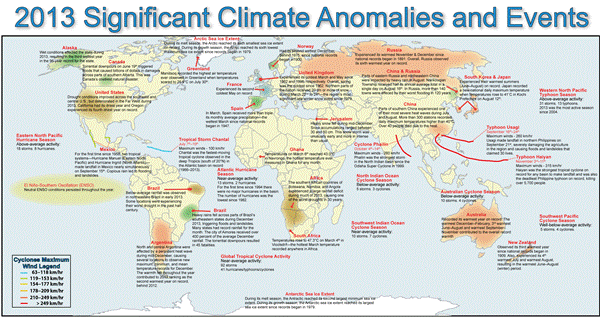As temperatures plummet across the country this week, it's important to remember that extreme weather and climate events—such as drought, heavy rain and heat waves—are a natural part of the Earth's climate system. Nonetheless, as the National Oceanic and Atmospheric Administration notes, extreme weather and climate events can have significant impacts on our lives and on the environment.
“In a non-changing climate, society and the environment are more likely to be resilient to weather and climate extremes as they acclimate to the historical range of extremes,” the NOAA states on its website. “However, as the climate changes these extremes may occur outside the historical range, resulting in societal and environmental vulnerabilities.”
 The NOAA's Global Analysis report for 2013 includes a Global Significant Weather and Climate Events world map illustrating some of Earth's most radical weather events last year.
The NOAA's Global Analysis report for 2013 includes a Global Significant Weather and Climate Events world map illustrating some of Earth's most radical weather events last year.
Recommended For You
Want to continue reading?
Become a Free PropertyCasualty360 Digital Reader
Your access to unlimited PropertyCasualty360 content isn’t changing.
Once you are an ALM digital member, you’ll receive:
- Breaking insurance news and analysis, on-site and via our newsletters and custom alerts
- Weekly Insurance Speak podcast featuring exclusive interviews with industry leaders
- Educational webcasts, white papers, and ebooks from industry thought leaders
- Critical converage of the employee benefits and financial advisory markets on our other ALM sites, BenefitsPRO and ThinkAdvisor
Already have an account? Sign In Now
© Touchpoint Markets, All Rights Reserved. Request academic re-use from www.copyright.com. All other uses, submit a request to [email protected]. For more inforrmation visit Asset & Logo Licensing.







